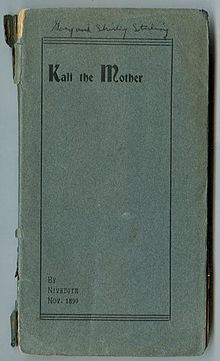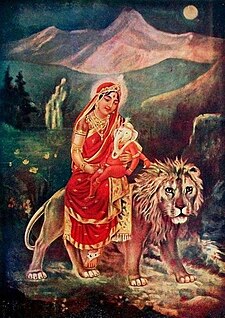
Parvati, Uma or Gauri is the Hindu goddess of power, energy, nourishment, harmony, love, beauty, devotion, and motherhood. She is a physical representation of Mahadevi in her complete form. She is also revered in her appearances as Durga and Kali. She is one of the central deities of the Goddess-oriented sect called Shaktism, and the chief goddess in Shaivism. Along with Lakshmi and Saraswati, she forms the Tridevi.

Durga also notably known as Jagadamba is a major, widely revered and one of the most popular deities in Hinduism. She is worshipped as a one of principal aspects of the supreme mother goddess Adi Shakti and is associated with protection, strength, motherhood, destruction and wars.

Bhārat Mātā is a national personification of India (Bharat) as a mother goddess. In the visual arts she is commonly depicted dressed in a red or saffron-coloured sari and holding a national flag or a saffron-coloured flag; she sometimes stands on a lotus and is accompanied by a lion.

Shaktism is one of several major Hindu denominations, wherein the metaphysical reality is considered metaphorically a woman and Shakti (Mahadevi) is regarded as the supreme godhead. It includes many goddesses, all considered aspects of the same supreme goddess. Shaktism has different sub-traditions, ranging from those focused on most worshipped Durga, gracious Parvati to that of fierce Kali.
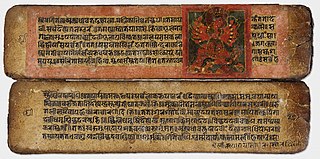
The Devi Mahatmya or Devi Mahatmyam is a Hindu philosophical text describing the Goddess as the supreme power and creator of the universe. It is part of the Markandeya Purana.

Dakshineswar Kali Temple is a Hindu navaratna temple in Dakshineswar, Kolkata, West Bengal, India. Situated on the eastern bank of the Hooghly River, the presiding deity of the temple is Bhavatarini, a form of Parashakti Adya Kali, otherwise known as Adishakti Kalika. The temple was built in 1855 by Rani Rashmoni, a Zamindar, philanthropist and a devotee of Kali. The temple is known for its association with Ramakrishna and Ma Sarada Devi, mystics of 19th Century Bengal.

Sister Nivedita was an Irish teacher, author, social activist, school founder and disciple of Swami Vivekananda. She spent her childhood and early youth in Ireland. She was engaged to marry a Welsh youth, but he died soon after their engagement.
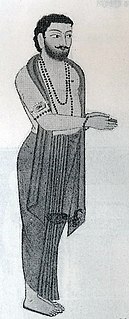
Sadhak Rāmprasād Sen was a Hindu Shakta poet and saint of eighteenth century Bengal. His bhakti poems, known as Ramprasadi, are still popular in Bengal—they are usually addressed to the Hindu goddess Kali and written in Bengali. Stories of Ramprasad's life typically include legends and myths mixed with biographical details.

Kali, also referred to as Mahakali, Bhadrakali and Kalika, is a Hindu goddess who is considered to be the goddess of ultimate power, time, destruction and change. She is considered as a ferocious form of goddess Mahadevi, the supreme of all powers, or the ultimate reality. Kali's earliest appearance is when she emerged from Shiva. She is the ultimate manifestation of Shakti and the mother of all living beings. The goddess destroys evil in order to protect the innocent. Over time, Kali has been worshipped by devotional movements and Tantric sects variously as the Divine Mother, Mother of the Universe, Principal energy Adi Shakti. Shakta Hindu and Tantric sects additionally worship her as the ultimate reality or Brahman. She is also seen as the divine protector and the one who bestows moksha or liberation.
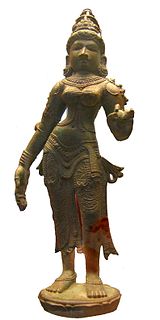
Devī is the Sanskrit word for 'goddess'; the masculine form is deva. Devi and deva mean 'heavenly, divine, anything of excellence', and are also gender-specific terms for a deity in Hinduism.

Kālikā Mata Temple is a Hindu goddess temple complex and pilgrim centre at the summit of Pavagadh Hill in Panchmahal District, India, with in the Champaner-Pavagadh Archaeological Park. It dates from the 10th or 11th centuries. The temple has three images of goddesses: the central image is of Kalika Mata, flanked by Kali on the right and Bahucharamata on the left. On Chitra sud 8, a fair is held at the temple which is attended by thousands of devotees. The temple is the site of one of the Great holy Shakti Peethas. One can easily reach the temple by ropeway.

The Web of Indian Life (1904) is a book written by Sister Nivedita. This book is a collection of essays and created a sensation when it was first published. The introduction of the book was written by Rabindranath Tagore.
Ramakrishna Sarada Mission Sister Nivedita Girls' School or Sister Nivedita Girls' School is a girls' school at Bagbazar, North Kolkata. It was established by Scottish-Irish social worker, author, speaker and disciple of Swami Vivekananda, Sister Nivedita, in November 1898.

An Indian Study of Love and Death (1908) is a book written by Sister Nivedita.

Religion and Dharma (1915) is a book written by Sister Nivedita. In this book Nivedita has discussed on the common principles of individual and social growth according to the law of Dharma.

Studies from an Eastern Home (1913) is an autobiographical book written by Sister Nivedita.

Notes of Some Wanderings with the Swami Vivekananda (1913) is an English-language book written by Sister Nivedita. In this book Nivedita has narrated the experiences she had while traveling with Swami Vivekananda in different parts of India.

Kali the Mother is a poem written by Hindu monk Swami Vivekananda. Vivekananda wrote the poem on 24 September 1898 when he was staying in Kashmir, on a houseboat, on Dal Lake in Srinagar. In this poem he worshipped goddess Kali.

Nachuk Tahate Shyama,, is a Bengali language poem written by Vivekananda. The poem was originally published in two issues in Vivekodayam in 1904. The poem was later included in the second volume of The Complete Works of Swami Vivekananda. The long poem relates to one's surrender to the Hindu goddess Shyama or Kali, and is also interpreted as "Let Kali dance there" a poem dedicated to Kali.

Vivekananda's prayer to Kali at Dakshineswar is the event in which Narendranath Datta, following the suggestion of Ramakrishna, went to the Kali temple of Dakshineswar with the intention to pray for financial welfare, but ultimately prayed for pure knowledge, devotion and renunciation. This event has been a subject of scholarly studies and is considered as a significant event in the life of Vivekananda, who initially revolted against idol-worship but now accepted and prayed before an idol of Kali. According to B. R. Kishore, "this incident added a new dimension to Narendra's devotion and knowledge".
